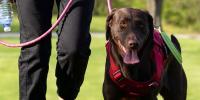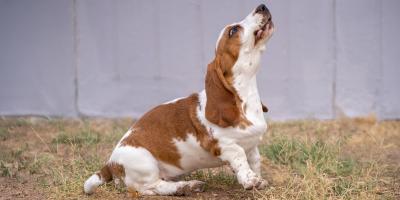Dog Training: Obedience Training for Older Dogs


Adult-dog obedience training can be a good idea for older pets. Whether you recently adopted an adult dog or your canine companion needs a refresh on basic commands, training your dog teaches them good behavior and strengthens your bond.
Additionally, despite what you may think, it is possible to train adult dogs. While they might be less impressionable than puppies, older canines have more self-control and can often focus for longer periods of time.
Curious about training for dogs? Find lessons on the MyPurina app or read on to learn training recommendations and how-to tips.
Does Your Adult Dog Need Obedience Training?
If you’re wondering if your dog needs obedience training, consider how serious their problem is.
For example, if your dog is generally well-behaved but doesn’t always sit still when you want them to, you may or may not want to spend time and energy fixing the issue.
However, for adult canines who engage in destructive or dangerous behavior, it’s recommended that you pursue dog obedience training.
Here are common examples of troublesome behaviors that can be improved through training:
- Leash-pulling. Walking calmly on a leash by your side doesn’t come naturally to most dogs (especially if your adult dog never learned how to do it). But with proper training, they can learn to walk without pulling.
- Digging. A dog who loves to dig can be destructive to your yard. By ensuring they get enough exercise and mental stimulation, you may be able to curb the behavior.
- Aggression. An aggressive dog may exhibit threatening behavior towards strangers, family members or other animals. If your pet is aggressive, they likely need intervention from an animal behaviorist in addition to training. Also, contact your veterinarian to rule out an underlying medical condition.
How to Obedience-Train an Older Dog at Home
If you want to train your older canine, here’s an overview of basic dog behaviors that can be taught at home.
Sit
- To teach your dog to sit, start by making eye contact with them.
- With the dog standing, hold a treat or kibble in front of their nose. This is called luring.
- Move the treat or kibble over their head towards their back, creating a natural sit. Move slowly and keep the treat or kibble directly in front of their nose.
- When your dog’s rear hits the ground, reinforce the behavior with a treat or kibble and praise them.
- Once the dog is reliably following the treat or kibble into a sit, you can then start using your empty hand in the same movement. Always reinforce the behavior with a treat or kibble and praise.
- When your dog is consistently sitting without the treat or kibble, add a verbal cue, such as “Sit.” The verbal cue should be said before you motion the puppy to sit with your hand.
Touch
- Show your dog the touch command (also known as “nose targeting”) by first holding your hand about an inch from their face.
- When they touch your hand with their nose, reinforce them with a treat or kibble.
- Once they’ve mastered touching your hand when it’s in front of their face, repeat the process while moving your hand around.
- Introduce the cue “Touch” once they consistently touch your hand.
Come
Teaching your dog to come can help keep them safe and focused on you.
- Make sure your dog knows their name before starting.
- Start in an environment that has little to no distractions, like a quiet room in your home.
- Use a happy voice and reinforcement that your dog likes, e.g., treats or toys. “Come” is important, so make sure reinforcement is something that makes them excited.
- Standing near your dog, say their name so they look at you and use a cue word, such as “Come.” Offer them a treat or toy to reinforce the behavior.
- As the dog becomes consistent with coming when you are close, try to call them when you are in a different room. (Don’t forget to use a happy voice, call their name and use your cue word.)
- Add some distractions. Have a friend or someone that lives in your home play with your dog. Don’t distract them with the treats or toys that you are using for reinforcement. While they are playing, call the dog by name and use your cue word.
- When the dog consistently comes with minor distractions, it is time to move outside.
- Repeat step seven but use a long line on your dog for safety.
- Remember, at any point when your dog doesn’t come consistently, you might have to go back a step, which is okay.
Don’t forget – make training a happy experience. Dogs don’t want to come if it is stressful for them.
Stay
- To teach the stay command, start with your dog in a neutral position they already know, such as sit, down or even stand.
- Once they’re sitting, put your hand flat in front of their face and give the cue: “Stay.”
- Take one step back from your dog while facing them.
- If your dog gets up, step back toward them. (If the dog has a hard time, have them get up on a dog-safe pedestal. After they master the behavior on the pedestal, then start training on the ground.)
- If your dog remains sitting, take a step forward to reinforce the stay.
- Repeat until they stay consistently.
- Next, try taking two steps back. If your dog follows you, go back to taking one step. Gradually increase the distance over time while using the cue, “Stay.”
- “Release” your dog by using a release word, like “Free” or “Break,” to let them know that they’re done with the behavior.
- Remember to praise (and treat, if needed) but do it calmly.
Heel
- To teach your dog to heel, first have them sit and stay.
- Turn away from them while putting a treat at your left hip.
- Start walking.
- As your dog walks next to you, following the treat, offer praise.
- If they move ahead or fall behind, repeat the “Heel” command, holding a treat by your hip.
Down
- The down behavior begins by making eye contact with your dog.
- Have your dog sit.
- Hold a small treat or piece of kibble in front of your dog’s nose.
- Move the food down to the ground, just in front of their front paws, then pull the treat slowly out along the ground, as if you’re drawing an “L” with the treat. With food in your hand, your dog is likely to follow.
- As your dog lies down, praise them calmly. After several sessions, add the verbal cue “Down.”
- Over time, you can pair this cue with other cues, like “Stay.”
Adult Dog Training Tips
As you consider how to train an older dog basic commands, here are some important tips to keep in mind:
- Be patient. Older dogs who learned bad habits over the years will need time to learn new behaviors.
- Start with simpler tasks. When you begin teaching a behavior, give your dog easier tasks, e.g., when teaching “Stay,” have them stay for only a few seconds.
- Commit to daily practice. In order for dog behavior training to be successful, you need to work on it every day. Many older dogs are able to focus on training, but they may need more time to learn than puppies. Keep your training sessions short – no more than 5-10 minutes.
- Use positive reinforcement. For best results, reinforce your adult dog when they follow your cues. Punishment is much more likely to make them afraid than teach a lesson. If they fail to listen, redirect them and start the cue over.
- Offer high-value treats or toys. Speaking of positive reinforcement, dog treats work well for rewarding good behavior, as do pieces of dry dog food, praise and pets. (Just be mindful of their daily caloric intake.)
- Coordinate with others in your home. Make sure everyone in your home who participates in training uses the same language, gestures and reinforcements. This provides consistency and avoids confusion for your pet.
- Mind your dog’s health. Older dogs may have health problems that make training difficult. For example, a senior dog with hip pain may resist sitting down repeatedly, despite your asking for that behavior.
When to Contact a Professional Dog Trainer
Adult-dog training at home is possible in many situations. Additionally, teaching basic obedience commands like “sit” and “stay” can be a good bonding opportunity for you and your pet.
There are, however, instances when contacting a professional dog trainer may be a good idea.
- Your dog is aggressive. For aggressive dogs, professional training and help from an animal behaviorist is recommended, especially if you’re new to training.
- You don’t have enough time. Busy schedules can make finding the time for daily training difficult.
- You prefer to learn in person. Some pet owners feel more comfortable having a professional personally show them how to train their dog.
- You’ve reached an impasse. If you feel like you’re doing everything right but your pet isn’t getting it, a professional trainer may be able to offer solutions.
Adult-dog obedience training is a good option for pets who never learned behaviors or were inconsistently trained. By following the right steps, using positive reinforcement, and practicing patience, you can help your older canine companion learn better behavior.
For more expert tips on training your dog, explore our dog training page.
Related articles

Reward Yourself with myPurina
Earn and redeem rewards for Purina products with the myPurina app.





